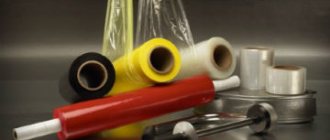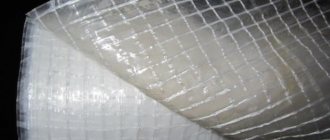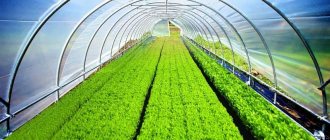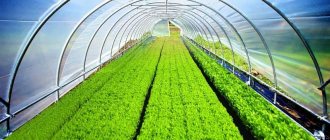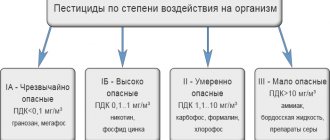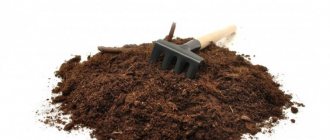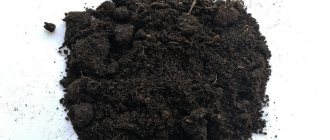It is important for the consumer to know the thickness of polyethylene film in order to choose what is needed and not overpay for the thickness. The density of the material can vary from 20 to 200 microns. The strength of the film and its consumption depend on this parameter. The thickness of the film also significantly affects its service life; the thicker it is, the longer the polymer retains its properties.
In the article we will consider in what cases it is appropriate to use one or another density, where one or another type is used.
Polyethylene film: production and material quality
Polyethylene film is a thin layer of material made from polyethylene. This is a polymer created from granules and additional substances by pressing a melt of material through a hole of a given shape. The popularity of polyethylene indicates a lot of its advantages:
- Does not change its shape under the influence of changes in the chemical environment. Inert. The property makes it possible to use the film in the field of catering;
- Has sufficient stretchability and elasticity. It is easy to wrap an object in it, slightly larger than the volume of a piece of material;
- Resistant to moisture and steam. Acts as a waterproofing material in construction, as a covering material and for packaging products;
- Does not allow air to pass through;
- Usually transparent – good visibility of the packaged product;
- Exhibits characteristic dielectric properties;
- Will last a long time.
- The material has minor disadvantages:
- Does not tolerate exposure to high temperatures (over 115 degrees);
- Loss of a number of characteristics (strength, elasticity) when exposed to direct sunlight;
- Fragility at temperatures below 10 degrees.
Printing (silk-screen printing, flexo printing), etc. is well displayed on polyethylene films.
Features and Properties
Polyethylene technical film is the result of remelting premium grade polyethylene that was in use or defective waste from its production.
It is not used for packaging medicines and food. The most pronounced difference between a technical variety and products of the first and highest grades is their appearance. The film does not look perfectly transparent; it has inclusions of unmelted particles, their number depends on the degree of cleaning. Recycled polyethylene can have non-uniform thickness. But in mechanical terms, this economical material is not inferior to virgin polyethylene. The finished product is not a toxic product, but the release of harmful fumes is possible during recycling in production
No precautions are required for its use indoors or outdoors, other than guarding against open flames. Film is a flammable product
When ignited, polyethylene burns and melts, releasing dangerous aldehydes.
Main characteristics of industrial film:
- specific sweetish odor (not an indicator of toxicity);
- rough surface;
- low (compared to grade 1) level of light transmission;
- shade from slightly gray or yellowish to colored and black (with the addition of dyes or soot);
- moisture resistance;
- tightness;
- a light weight;
- resistance to temperatures from -60 to +60°;
- good tensile strength and tensile strength in the longitudinal and transverse directions;
- depending on the thickness, resistance to damage also increases;
- low cost;
- a wide range of;
- The warranty period is from 3 years or more.
Types of polyethylene films
Manufacture: GOST 10354-82. The material is classified according to the composition of the raw materials - HDPE (low pressure) and LDPE (high pressure), according to the number of layers of polyethylene - one or several layers. Polyethylene film contains a number of additives that help improve its qualities. The fabric is divided into types based on the presence of additives.
The composition and technology of their production makes it possible to classify the material into types:
The list can be continued. The film is classified according to its release form into sheet, sleeve and half-sleeve. The fabric is without seams or folds, the sleeve is a rolled cord, the half-sleeve is a sleeve with one side cut.
Types of polyethylene and methods of production
A distinction is made between high-density polyethylene, which has a low density (Low-Density PE), and low-density polyethylene, which has a high density (High-Density PE). That is, these are two types of polyethylene under the Russian markings LDPE and HDPE.
Low-density polyethylene is produced by radical polymerization under pressure conditions of 120-150 MPa with the participation of oxygen or peroxides. LDPE is characterized by multiple chains of long branches in the polymer chain.
High-density polyethylene is produced using catalytic polymerization technology and has the characteristic of linear structures with the presence of short side branches.
The density of polyethylene is measured in the proportion of units kg per m3.
LDPE has indicators of 910 - 925 kg/m3.
HDPE has indicators of 941 - 965 kg/m3.
Technological processes also make it possible to produce medium-pressure PE with indicators of 926 - 940 kg/m3.
Polyethylene films: sizes and density
The canvas has a standard density - from 20 to 200 microns. The selection of material of a given density is carried out, guided by the tasks - for a greenhouse, repair, construction, etc. Sales are made in rolls (winding ranges from 80 to 200 linear meters). The standard sleeve width is 1.5 m, the turn is 3 m, the winding is 100 linear meters. Construction stores sell film in sections. The length varies - from 1 to 10 meters. Manufacturers can custom make material dimensions of non-standard width.
Sheet polyethylene (PE)
| Sheet thickness, mm | Sheet weight 1500x3000 mm, kg | Weight m2, kg |
| 3 | 12,9 | 2,9 |
| 4 | 17,1 | 3,8 |
| 5 | 21,4 | 4,8 |
| 6 | 25,7 | 5,7 |
| 8 | 34,3 | 7,6 |
| 10 | 42,9 | 9,5 |
| 12 | 51,4 | 11,4 |
| 15 | 64,3 | 14,3 |
| 20 | 85,7 | 19,1 |
| 25 | 107,1 | 23,8 |
| 30 | 128,9 | 28,7 |
| 35 | 150,4 | 33,4 |
| 38-40 | 171,9 | 38,2 |
Color: black, natural (white), blue and others.
Additional information on model sheets:
Physiological properties: Due to its composition, polyethylene material is allowed for use in the food industry. Extruded sheet is more chemical resistant and environmentally friendly compared to traditional polystyrene and PVC.
Physical properties: Sheet plastic has high impact strength when impacted with a notch, especially at low temperatures, good resistance to abrasion and corrosion cracking.
Chemical properties: Under normal conditions, sheet plastic is resistant to organic solvents such as alcohols, esters and ketones, as well as acids even at high concentrations, only unlike polypropylene at not very high temperatures - not higher than 40 ° C. Resistant to mineral and vegetable oils even with prolonged exposure.
Only strong oxidizing agents have a noticeable effect on polyethylene: chlorosulfonic acid, sulfuric (oleum) and concentrated nitric acids, chromic mixture.
Electrical properties: Polyethylene sheets are characterized by good electrical insulating properties over a wide temperature range.
Transportation and storage of sheets: Sheets and slabs made of polyethylene are transported and stored on special pallets. They can be transported by ordinary vehicles, preferably closed. When transporting, sheets must be placed on a pallet and secured. Other methods of transportation are not recommended, taking into account the possibility of damage to the sheets. Polyethylene sheets are stored on a horizontal, flat surface, preferably on special pallets with mandatory liner between sheets of packing paper or other backing material. Sheets that are not UV stabilized should be stored indoors, protected from sunlight. Sheets stabilized against ultraviolet radiation can be stored in open areas, but they must be protected from contamination.
Fire hazard characteristics of sheets: In case of fire hazard, polyethylene sheets have the following characteristics:
- flammability group – G4 according to GOST 30244;
- smoke generating ability – D3 according to GOST 12.1.044;
- flammability group – B2 according to GOST 30402;
- toxicity indicator – T4 according to GOST 12.1.044
Processing methods:
- Mechanical processing (cutting, sawing, drilling)
- Laser cutting, etc.
- Molding
- Contact welding, ultrasonic, gun, extruder
- Bending
Scope of application: containers for acids, alkalis, diesel fuel, fuels and lubricants, containers for transportation and storage, swimming pool bowls, septic tanks, pallets, air ducts, containers for fish farming, construction, equipment and containers for the chemical industry, coverings for temporary sites and roads for heavy technology, automotive industry, mechanical engineering, electrical engineering, etc.
Where is polyethylene film used?
The film is used in production areas and industries:
Areas of use
Technical film serves as a universal solution to many agricultural problems and is used:
- when mulching the soil;
- for covering greenhouses and hay;
- when constructing silos and waste pits, drainage trenches;
- for storage and transportation of agricultural products.
This product is in great demand in construction. Everyone has seen scaffolding covered with polyethylene. Under such protection, you can continue working even in bad weather. Technical black film plays the role of an excellent insulating material in such manipulations:
- carrying out roofing and facade works;
- laying the foundation (to protect against groundwater);
- pipe laying.
Polyethylene for waterproofing is advantageous because it is thin, but dense, does not rot and is not susceptible to bacteria. Polyethylene sheets are used to protect construction materials unloaded onto the site from rain and sun. Not a single interior or exterior renovation is complete without technical film, which is used to cover windows and walls, cover floors and furniture, so that dust, plaster and paint do not get on them. A wide range of applications is packaging of all kinds of non-food products, such as:
- window and door blocks;
- finishing materials (wallpaper, adhesives, mixtures);
- rolls of fabric;
- paper, books and stationery;
- furniture;
- Appliances;
- household chemicals;
- various devices and instruments.
The film plays the role of additional protection for cardboard containers, ensuring tightness and safety of the contents. In any home you can find garbage bags made of technical polyethylene of various capacities.
In the next video you will find a brief overview of the technical film.
Price of polyethylene film
The price of the material is determined by the composition of the raw materials from which the film was made. There are two types of film: primary and secondary. In the manufacture of the first type of material, primary polyethylene granules are used. The second type of finished film mainly consists of recycled polyethylene granules or includes only polyethylene waste. This species is characterized by sufficient fragility. Recycled film has a limited lifespan. The manufacturer often makes discounts on material in case of wholesale purchase. Purchasing plastic film is not an easy task. There are a huge number of types of material in terms of fabric density, size, functionality, as well as the raw materials from which the final product is made. First of all, you need to be guided by the main purpose of the material. Often, construction stores can advise on what purpose polyethylene film of a certain density and dimensions is suitable for. Independent knowledge of information will allow you to make the right and quick choice and use plastic film for its intended purpose for a long time.
Production
The main negative property of plastic polymers is their long natural decomposition period. By including special biodegradable additives in the composition, this process can be accelerated, but still the planet is literally suffocating from such waste. Until recently, plastic was disposed of only in two essentially barbaric ways: burning and burial.
Reusing the material to obtain technical film is an excellent solution that is economically and environmentally beneficial. Recyclable materials for polyethylene recycling:
- unused products recognized as manufacturing defects;
- industrial waste of the same type;
- sorted waste.
Defects in production make up a very small part of the total mass of raw materials: about 10%. Therefore, when recycling, sorting and purification of polymers that have already been in use comes to the fore. The process of recycling polyethylene in production looks like this:
- collected recyclable materials are sorted, washed and cleaned;
- the material is crushed in a crusher;
- remove excess impurities and moisture using a centrifuge;
- carry out thorough drying;
- In a granulator or agglomerator, granules or agglomerate (polyethylene chips) are formed from molten raw materials.
An agglomerator is a special device that can have either a simple design with manual loading of raw materials and water, or be a complex computerized complex. The molten polymer raw material in the agglomerator is cooled by shock supply of cold water, while sintering forms peculiar flakes (agglomerate). The products obtained in the granulator and agglomerator are different. For example, the transparency of secondary granules will be higher than that of agglomerate.
The granules also have a more uniform structure and bulk density. The film produced from them will be little inferior to the primary material in terms of quality and transparency. The final product is obtained by loading the crumbs into an extruder and passing them through a screw at high temperatures. Then the film web passes through forming heads of different profiles, is cooled, wound on rollers and prepared for distribution to retail chains in rolls.
Film for greenhouses.
Thin ones transmit light better, thick ones are stronger and last longer. Covering film thickness: 100 microns (0.1 mm) to 200 microns (0.2 mm). Adding stabilizers to polyethylene increases its strength and light transmittance.
Film thickness is important for calculating the load on the greenhouse frame. The cheapest unstabilized polyethylene film 100 microns weighs about 200 grams per linear meter. With a thickness of 200 microns - already more than 500 grams.
